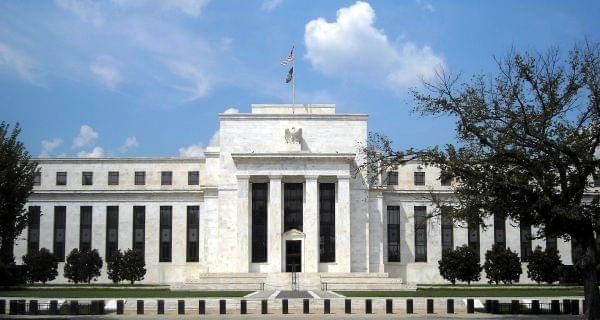Federal Reserve Raises Key Interest Rate In First Move Since 2015

The Federal Reserve Building in Washington, D.C. Wikimedia Commons
America's central bank is nudging its benchmark interest rate higher, announcing a move from the current 0.25-0.50 percent to a range of 0.50 and 0.75 percent. The decision emerged from a session of the Federal Open Market Committee Wednesday.
Analysts had widely expected the hike of a quarter of a percentage point, and with a low unemployment rate and signs of growth among workers' wages, more boosts could follow in 2017. The Federal Reserve said today that its officials expect "only gradual increases in the federal funds rate."
The vote to nudge benchmark interest rates higher was unanimous, the central bank says. The federal funds rate has fallen sharply since reaching its recent high in June of 2006, when the rate stood at 5.25 percent.
The rates decision was announced at 2 p.m. ET. Announcing its decision, the Fed noted that inflation has increased "but is still below the Committee's 2 percent longer-run objective, partly reflecting earlier declines in energy prices and in prices of non-energy imports."
The rate hike is the first of the year — despite signals from the Fed when it raised rates at the end of 2015 that more boosts were likely in 2016. While economists were encouraged to see U.S. workers' wages finally rising this year, international developments (China's slowdown, Brexit) complicated the picture.
The interest-rate decision follows a two-day meeting of the Federal Open Market Committee. For analysis of the economic picture officials are seeing — and how it might change — here's David Wessel, director of the Hutchins Center at the Brookings Institution, who spoke about the Fed's expected move to NPR's Steve Inskeep for today's Morning Edition:
"They're afraid that we're now at the point where the economy is so close to full employment that they'll get more inflation than they want, so they're gradually taking their foot off the monetary accelerator. Interest rates are still pretty low, but they're starting to go up: Mortgage rates, for instance, were 3.5 percent on a 30-year mortgage earlier this year; [they] are now well above 4 percent. So, interest rates on savings and borrowing are going to go up a little bit over the next year."
In addition to the country's economy, Yellen and her colleagues are also expected to take into account the ongoing political transition in Washington, where President-elect Donald Trump is preparing to take power and Republicans will continue to lead Congress.
Here's how Wessel, who's a contributing correspondent to The Wall Street Journal, sees the political context:
"The picture has changed a lot since the election. Most people in Washington and the markets expect a tax cut, an increase in spending on defense for sure, maybe on infrastructure. And so in the short-run that'll give the economy a little more oomph, and that's leading people to think the Fed may raise increase rates a little faster than had been anticipated before the election."
Raising interest rates is also attractive to federal banking officials who want to accomplish a number of goals — from reloading its most powerful weapon to stimulate the economy to preventing potential bubbles from forming in either the investment or housing sectors.
As NPR's Marilyn Geewax reported ahead of last year's rate hike, "if rates already are as low as possible, then the Fed doesn't have that weapon available to fight off a recession."
